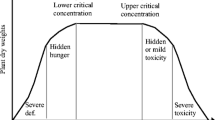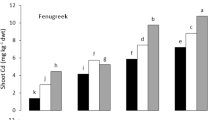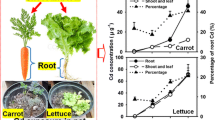Abstract
Copper (Cu) can be toxic to vegetables when it is absorbed and accumulated at large concentrations, a fact that increases the risk of excessive addition of this metal to the human food chain. The aims of the current study are (1) to determine the Cu concentrations that have critical toxic effects on beet and cabbage plants, and the potential of these plants to enter the human food chain, as well as (2) to assess the physiological and biochemical responses of representatives of these vegetables grown in nutrient solution presenting increasing Cu concentrations. Beet and cabbage plants were grown for 75 days in pots filled with sand added with nutrient solution presenting six Cu concentrations: 0.00, 0.52, 1.02, 1.52, 2.02 and 2.52 mg Cu L−1. Dry matter yield and Cu accumulation in different plant organs were evaluated. Photosynthetic pigment contents, lipid peroxidation levels (TBARs), superoxide dismutase (SOD) and peroxidase (POD) activity and hydrogen peroxide (H2O2) concentrations in leaves were evaluated. Critical Cu concentrations that led to toxicity in plant organs such as beetroot and cabbage head, which are often found in human diets, corresponded to 1.43 mg Cu L−1 and 1.59 mg Cu L−1, respectively. High Cu concentrations in the nutrient solution have increased Cu concentrations and accumulation in plant tissues. This outcome justified the increased POD and SOD enzyme activity in the leaves of beet and cabbage plants, respectively, and was the cause of reduced plant growth in both crops. Cabbage plants presented higher tolerance to increased Cu levels in the growing environment than beet plants. However, it is necessary being careful at the time to consume both vegetables, when they are grown in Cu-enriched environments.




Similar content being viewed by others
Data availability
The datasets used and/or analyzed during the current study are available from the corresponding author on reasonable request.
References
Adrees M, Ali S, Rizwan M, Ibrahim M, Abbas F, Farid M, Zia-ur-Rehman M, Irshad MK, Bharwana SA (2015) The effect of excess copper on growth and physiology of important food crops: a review. Environ Sci Pollut Res 22:8148–8162. https://doi.org/10.1007/s11356-015-4496-5
Ali S, Shahbaz M, Shahzad AN, Khan HAA, Anees M, Haider MS, Fatima A (2015) Impact of copper toxicity on stone-head cabbage (Brassica oleracea var. capitata) in hydroponics. PeerJ 3:e1119. https://doi.org/10.7717/peerj.1119
Ambrosini VG, Rosa DJ, Corredor Prado JP, Borghezan M, Bastos de Melo GW, de Sousa F, Soares CR, Comin JJ, Simão DG, Brunetto G (2015) Reduction of copper phytotoxicity by liming: A study of the root anatomy of young vines (Vitis labrusca L.). Plant Physiol Biochem 96:270–280. https://doi.org/10.1016/j.plaphy.2015.08.012
Ambrosini VG, Rosa DJ, Bastos de Melo GW, Zalamena J, Cella C, Simão DG, Souza da Silva L, Pessoa dos Santos H, Toselli M, Tiecher TL, Brunetto G (2018) High copper content in vineyard soils promotes modifications in photosynthetic parameters and morphological changes in the root system of ‘Red Niagara’ plantlets. Plant Physiol Biochem 128:89–98. https://doi.org/10.1016/J.PLAPHY.2018.05.011
Belhaj D, Jerbi B, Medhioub M, Zhou J, Kallel M, Ayadi H (2016) Impact of treated urban wastewater for reuse in agriculture on crop response and soil ecotoxicity. Environ Sci Pollut Res 23:15877–15887. https://doi.org/10.1007/s11356-015-5672-3
Bicalho da Silva IC, Tiecher TL, Schneider JM, Trentin E, De Conti L, Ferreira PAA, Ceretta CA, Araújo MM, Tarouco CP, Garlet LP, Hammerschmitt RK, Brunetto G (2018) Growth, biochemical response and nutritional status of Angico-Vermelho ( Parapiptadenia rigida (Bentham) Brenan) under the application of soil amendment in Cu-contaminated soil. Int J Phytoremediation 20:1380–1388. https://doi.org/10.1080/15226514.2018.1474438
Brasil, A.N. de V.S.-A., 2005. Regulamento técnico sobre a ingestão diária recomendada (idr) de proteína, vitaminas e minerais. Brasil.
Brunetto G, Wellington G, Melo B, De Terzano R, Del D, Astol S, Tomasi N, Pii Y, Mimmo T, Cesco S (2016) Chemosphere Copper accumulation in vineyard soils : Rhizosphere processes and agronomic practices to limit its toxicity 162, 293–307. https://doi.org/10.1016/j.chemosphere.2016.07.104
Cambrollé J, García JL, Ocete R, Figueroa ME, Cantos M (2013) Growth and photosynthetic responses to copper in wild grapevine. Chemosphere 93:294–301. https://doi.org/10.1016/J.CHEMOSPHERE.2013.04.080
Cambrollé J, García JL, Figueroa ME, Cantos M (2015) Chemosphere Evaluating wild grapevine tolerance to copper toxicity 120, 171–178. https://doi.org/10.1016/j.chemosphere.2014.06.044
Cesar Da, F., Técnico, S.E., 2009. Empresa Brasileira de Pesquisa Agropecuária Embrapa Solos Embrapa Informática Agropecuária Ministério da Agricultura, Pecuária e Abastecimento 2a edição revista e ampliada.
Comin JJ, Ambrosini VG, Rosa DJ, Basso A, Loss A, Melo GWB, de Lovato PE, Lourenzi CR, Ricachenevsky FK, Brunetto G, Comin JJ, Ambrosini VG, Rosa DJ, Basso A, Loss A, Melo GWB, de Lovato PE, Lourenzi CR, Ricachenevsky FK, Brunetto G (2018) Liming as a means of reducing copper toxicity in black oats. Ciência Rural 48. https://doi.org/10.1590/0103-8478cr20170278
Cuba-Díaz, M., Marín, C., Castel, K., Machuca, Á., Rifo, S., 2017. Effect of copper (II) ions on morpho-physiological and biochemical variables in Colobanthus quitensis 430 Cuba-Díaz et al. J. Soil Sci. Plant Nutr. 17, 429–440.
Cui X, Sun X, Hu P, Yuan C, Luo Y, Wu L, Christie P (2015) Concentrations of Heavy Metals in Suburban Horticultural Soils and Their Uptake by Artemisia selengensis. Pedosphere 25:878–887. https://doi.org/10.1016/S1002-0160(15)30068-0
Davis RD., Beckett P HT, Wollan E (1978) Critical levels of twenty potentially toxic elements in young spring barley. Plant and Soil 49(2):395–408
De Conti L, Ceretta CA, Ferreira PAA, Lourenzi CR, Girotto E, Lorensini F, Tiecher TL, Marchezan C, Anchieta MG, Brunetto G (2016) Soil solution concentrations and chemical species of copper and zinc in a soil with a history of pig slurry application and plant cultivation. Agric Ecosyst Environ 216:374–386. https://doi.org/10.1016/J.AGEE.2015.09.040
De Vos CHR, Schat H, Vooijs R, Ernst WHO (1989) Copper-induced Damage to the Permeability Barrier in Roots of Silene cucubalus. J Plant Physiol 135:164–169. https://doi.org/10.1016/S0176-1617(89)80171-3
Dey, S., Mazumder, P.B., Paul, S.B., 2014. Effect of copper on growth and chlorophyll content in tea plants (Camellia sinensis (l.) O. Kuntze) 2, 223–230.
Ding Z, Li Y, Sun Q, Zhang H, Ding Z, Li Y, Sun Q, Zhang H (2018) Trace Elements in Soils and Selected Agricultural Plants in the Tongling Mining Area of China. Int J Environ Res Public Health 15:202. https://doi.org/10.3390/ijerph15020202
Embrapa EBDPA (2009) Manual de análises químicas de solos, plantas e fertilizantes. Brasília: Embrapa Informação Tecnológica, Embrapa Solos, Brasília
El-moshaty FIB, Pike SM, Novacky AJ, Sehgal OP (1993) Lipid peroxidation and superoxide production in cowpea (Vigna unguiculata) leaves infected with tobacco ringspot virus or southern bean mosaic virus. Physiol Mol Plant Pathol 43:109–119. https://doi.org/10.1006/PMPP.1993.1044
FDA (Food and Drug Administration), 2001. Dietary Reference Intakesfor Vitamin A, Vitamin K, Arsenic, Boron, Chromium, Copper, Iodine, Iron, Manganese, Molybdenum, Nickel, Silicon, Vanadium,and Zinc [WWW Document]. Cent. Food Saf. Appl. Nutr. URL https://s3.amazonaws.com/public-inspection.federalregister.gov/2016-11867.pdf (accessed 7.1.19).
Filgueira, F.A.R., 2012. Novo manual de olericultura: agrotecnologia moderna na produção e comercialização de hortaliças, UFV. ed. Viçosa.
Flores-Cáceres ML, Hattab S, Hattab S, Boussetta H, Banni M, Hernández LE (2015) Specific mechanisms of tolerance to copper and cadmium are compromised by a limited concentration of glutathione in alfalfa plants. Plant Sci 233:165–173. https://doi.org/10.1016/J.PLANTSCI.2015.01.013
Giannopolitis CN, Ries SK (1977) Superoxide Dismutases: II. Purification and Quantitative Relationship with Water-soluble Protein in Seedlings. Plant Physiol 59:315–318. https://doi.org/10.1104/pp.59.2.315
Gill SS, Tuteja N (2010) Reactive oxygen species and antioxidant machinery in abiotic stress tolerance in crop plants. Plant Physiol Biochem 48:909–930. https://doi.org/10.1016/j.plaphy.2010.08.016
Girotto E, Ceretta CA, Rossato LV, Farias JG, Tiecher TL, De Conti L, Schmatz R, Brunetto G, Schetinger MRC, Nicoloso FT (2013) Triggered antioxidant defense mechanism in maize grown in soil with accumulation of Cu and Zn due to intensive application of pig slurry. Ecotoxicol Environ Saf 93:145–155. https://doi.org/10.1016/J.ECOENV.2013.03.021
Hiscox JD, Israelstam GF (1979) A method for the extraction of chlorophyll from leaf tissue without maceration. Can J Bot 57:1332–1334. https://doi.org/10.1139/b79-163
Hu W, Huang B, Tian K, Holm PE, Zhang Y (2017) Heavy metals in intensive greenhouse vegetable production systems along Yellow Sea of China: Levels, transfer and health risk. Chemosphere 167:82–90. https://doi.org/10.1016/j.chemosphere.2016.09.122
İşeri ÖD, Körpe DA, Yurtcu E, Sahin FI, Haberal M (2011) Copper-induced oxidative damage, antioxidant response and genotoxicity in Lycopersicum esculentum Mill. and Cucumis sativus L. Plant Cell Rep 30:1713–1721. https://doi.org/10.1007/s00299-011-1079-x
Jan S, Parray JA (2016) Heavy Metal Uptake in Plants, in: Approaches to Heavy Metal Tolerance in Plants. Springer Singapore, Singapore, pp. 1–18. https://doi.org/10.1007/978-981-10-1693-6_1
Janicka-Russak M, Kabała K, Burzyński M, Kłobus G (2008) Response of plasma membrane H+-ATPase to heavy metal stress in Cucumis sativus roots. J Exp Bot 59:3721–3728. https://doi.org/10.1093/jxb/ern219
Kabata-Pendias A (2011) Trace elements in soils and plants. CRC Press. Boca Ratón, Florida
Karabourniotis G, Liakopoulos G, Nikolopoulos D, Bresta P (2020) Protective and defensive roles of non-glandular trichomes against multiple stresses: structure–function coordination. J for Res 31:1–12. https://doi.org/10.1007/s11676-019-01034-4
Karimi P, Khavari-Nejad RA, Niknam V, Ghahremaninejad F, Najafi F (2012) The effects of excess copper on antioxidative enzymes, lipid peroxidation, proline, chlorophyll, and concentration of Mn, Fe, and Cu in Astragalus neo-mobayenii. ScientificWorldJournal 2012:615670. https://doi.org/10.1100/2012/615670
Karuppanapandian T, Moon J-C, Kim C, Manoharan K, Kim W (2011) Reactive Oxygen Species in Plants: Their Generation, Signal Transduction, and Scavenging Mechanisms. Aust J Crop Sci 5:709–725
Keller C, Rizwan M, Davidian J-C, Pokrovsky OS, Bovet N, Chaurand P, Meunier J-D (2015) Effect of silicon on wheat seedlings (Triticum turgidum L.) grown in hydroponics and exposed to 0 to 30 µM Cu. Planta 241:847–860. https://doi.org/10.1007/s00425-014-2220-1
Kopsell, D.E., Kopsell, D.A., 2007. Copper, in: Barker, A.V., Pilbeam, D.J. (Eds.), Handbook of Plant Nutrition. Taylor and Francis Group, Boca Raton, pp. 293–328.
Kováč J, Lux A, Vaculík M (2018) Formation of a subero-lignified apical deposit in root tip of radish (Raphanus sativus) as a response to copper stress. Ann Bot 122:823–831. https://doi.org/10.1093/aob/mcy013
Lequeux H, Hermans C, Lutts S, Verbruggen N (2010) Response to copper excess in Arabidopsis thaliana: Impact on the root system architecture, hormone distribution, lignin accumulation and mineral profile. Plant Physiol Biochem 48:673–682. https://doi.org/10.1016/J.PLAPHY.2010.05.005
Lichtenthaler HK (1987) Chlorophylls and carotenoids: Pigments of photosynthetic biomembranes. Methods Enzymol 148:350–382. https://doi.org/10.1016/0076-6879(87)48036-1
Liu JJ, Wei Z, Li JH (2014) Effects of copper on leaf membrane structure and root activity of maize seedling. Bot Stud 55:47. https://doi.org/10.1186/s40529-014-0047-5
Loreto F, Velikova V (2001) Isoprene produced by leaves protects the photosynthetic apparatus against ozone damage, quenches ozone products, and reduces lipid peroxidation of cellular membranes. Plant Physiol 127:1781–1787
Marschner H, Marschner P (2012) Mineral nutrition of higher plants. Academic Press
Mateos-Naranjo E, Andrades-Moreno L, Cambrollé J, Perez-Martin A (2013) Assessing the effect of copper on growth, copper accumulation and physiological responses of grazing species Atriplex halimus: Ecotoxicological implications. Ecotoxicol Environ Saf 90:136–142. https://doi.org/10.1016/j.ecoenv.2012.12.020
Michaud AM, Chappellaz C, Hinsinger P (2008) Copper phytotoxicity affects root elongation and iron nutrition in durum wheat (Triticum turgidum durum L.). Plant Soil 310:151–165. https://doi.org/10.1007/s11104-008-9642-0
Miotto A, Ceretta CA, Brunetto G, Nicoloso FT, Girotto E, Farias JG, Tiecher TL, De Conti L, Trentin G (2014) Copper uptake, accumulation and physiological changes in adult grapevines in response to excess copper in soil. Plant Soil 374:593–610. https://doi.org/10.1007/s11104-013-1886-7
Miotto A, Ceretta CA, Girotto E, Trentin G, Kaminski J, De Conti L, T, M, Elena B, Brunetto G (2017) Copper Accumulation and Availability in Sandy, Acid, Vineyard Soils. Commun. Soil Sci. Plant Anal. 48, 1167–1183.
Morales JML, Rodríguez-Monroy M, Sepúlveda-Jiménez G (2012) Betacyanin accumulation and guaiacol peroxidase activity in Beta vulgaris L. leaves following copper stress. Acta Soc Bot Pol 81:193–201. https://doi.org/10.5586/asbp.2012.019
Mourato MP, Moreira IN, Leitão I, Pinto FR, Sales JR, Martins LL (2015) Effect of Heavy Metals in Plants of the Genus Brassica. Int J Mol Sci 16:17975–17998. https://doi.org/10.3390/ijms160817975
Murphy AS, Eisinger WR, Shaff JE, Kochian LV, Taiz L (1999) Early copper-induced leakage of K(+) from Arabidopsis seedlings is mediated by ion channels and coupled to citrate efflux. Plant Physiol 121:1375–1382. https://doi.org/10.1104/pp.121.4.1375
Oorts, K., 2013. Key heavy metals and metalloids. Heavy metals in soil. Springer, Dordrecht, 367–394. https://doi.org/10.1007/978-94-007-4470-7_13
Palm E, Guidi Nissim W, Giordano C, Mancuso S, Azzarello E (2017) Root potassium and hydrogen flux rates as potential indicators of plant response to zinc, copper and nickel stress. Environ Exp Bot 143:38–50. https://doi.org/10.1016/J.ENVEXPBOT.2017.08.009
Pan X-D, Wu P-G, Jiang X-G (2016) Levels and potential health risk of heavy metals in marketed vegetables in Zhejiang, China. Sci Rep 6:20317. https://doi.org/10.1038/srep20317
Passardi F, Cosio C, Penel C, Dunand C (2005) Peroxidases have more functions than a Swiss army knife. Plant Cell Rep 24:255–265. https://doi.org/10.1007/s00299-005-0972-6
Radulescu C, Stihi C, Popescu IV, Dulama ID, Chelarescu ED, Chilian A (2013) Heavy metal accumulation and translocation in different parts of Brassica oleracea L Rom. J Phys 58:1337–1354
Rodrigo-Moreno A, Andrés-Colás N, Poschenrieder C, Gunsé B, Peñarrubia L, Shabala S (2013) Calcium- and potassium-permeable plasma membrane transporters are activated by copper in Arabidopsis root tips: linking copper transport with cytosolic hydroxyl radical production. Plant Cell Environ 36:844–855. https://doi.org/10.1111/pce.12020
Ryan BM, Kirby JK, Degryse F, Harris H, Mclaughlin MJ, Scheiderich K, Ryan B (2013) Copper speciation and isotopic fractionation in plants: uptake and translocation mechanisms. New Phytol 199:367–378. https://doi.org/10.1111/nph.12276
Sánchez-Pardo B, Fernández-Pascual M, Zornoza P (2014) Copper microlocalisation and changes in leaf morphology, chloroplast ultrastructure and antioxidative response in white lupin and soybean grown in copper excess. J Plant Res 127:119–129. https://doi.org/10.1007/s10265-013-0583-1
Sharma P, Jha AB, Dubey RS, Pessarakli M (2012) Reactive Oxygen Species, Oxidative Damage, and Antioxidative Defense Mechanism in Plants under Stressful Conditions. J Bot 2012:1–26. https://doi.org/10.1155/2012/217037
Sun FF, Wang FH, Wang X, He W, Wen D, Wang QF, Liu XX (2013) Soil threshold values of total and available cadmium for vegetable growing based on field data in Guangdong province, South China. J Sci Food Agric 93:1967–1973. https://doi.org/10.1002/jsfa.6000
Tazzo IF, Heldwein AB, Maldaner IC, Pivetta CR, Streck L, Righi EZ (2012) Evapotranspiração do pimentão em estufa plástica estimada com dados meteorológicos externos, na primavera. Rev Bras Eng Agrícola e Ambient 16:275–280. https://doi.org/10.1590/S1415-43662012000300007
Tiecher TL, Soriani HH, Tiecher T, Ceretta CA, Nicoloso FT, Tarouco CP, Clasen BE, De Conti L, Tassinari A, Melo GWB, Brunetto G (2018) The interaction of high copper and zinc doses in acid soil changes the physiological state and development of the root system in young grapevines (Vitis vinifera). Ecotoxicol Environ Saf 148:985–994. https://doi.org/10.1016/J.ECOENV.2017.11.074
Trentin E, Facco DB, Hammerschmitt RK, Avelar Ferreira PA, Morsch L, Belles SW, Ricachenevsky FK, Nicoloso FT, Ceretta CA, Tiecher TL, Tarouco CP, Berghetti ÁLP, Toselli M, Brunetto G (2019) Potential of vermicompost and limestone in reducing copper toxicity in young grapevines grown in Cu-contaminated vineyard soil. Chemosphere 226:421–430. https://doi.org/10.1016/j.chemosphere.2019.03.141
Wu W, Wan X, Shah F, Fahad S, Huang J (2014) The role of antioxidant enzymes in adaptive responses to sheath blight infestation under different fertilization rates and hill densities. ScientificWorldJournal 2014:502134. https://doi.org/10.1155/2014/502134
Xu X, Xu Y, Chi Y, Wang P, Shi G, Xu XY (2015) Changes of Essential Mineral Elements Contents in Response to Cu 2+ Treatment in Sagittaria sagittifolia. J. Environ. Prot. (Irvine,. Calif) 6:700–709. https://doi.org/10.4236/jep.2015.67063
Yang X, Li Q, Tang Z, Zhang W, Yu G, Shen Q, Zhao F-J (2017) Heavy metal concentrations and arsenic speciation in animal manure composts in China. Waste Manag 64:333–339. https://doi.org/10.1016/J.WASMAN.2017.03.015
You J, Chan Z (2015) ROS Regulation During Abiotic Stress Responses in Crop Plants. Front Plant Sci 6:1092. https://doi.org/10.3389/fpls.2015.01092
Yu R, Tang Y, Liu C, Du X, Miao C, Shi G (2017) Comparative transcriptomic analysis reveals the roles of ROS scavenging genes in response to cadmium in two pak choi cultivars. Sci Rep 7:9217. https://doi.org/10.1038/s41598-017-09838-2
Zeraik AE, Sant’ F, De Souza A, Fatibello-Filho O, Leite OD (2008) Desenvolvimento de um spot test para o monitoramento da atividade da peroxidase em um procedimento de purificação. Quim. Nov. 31, 731–734.
Zhu Z, Wei G, Li J, Qian Q, Yu J (2004) Silicon alleviates salt stress and increases antioxidant enzymes activity in leaves of salt-stressed cucumber (Cucumis sativus L.). Plant Sci 167:527–533. https://doi.org/10.1016/J.PLANTSCI.2004.04.020
Acknowledgements
We are grateful to Conselho Nacional de Desenvolvimento Científico e Tecnológico (Brazilian National Council for Scientific and Technological Development)-CNPq, for the research productivity scholarship, granted to the second author.
Funding
Conselho Nacional de Desenvolvimento Científico e Tecnológico (Brazilian National Council for Scientific and Technological Development) – CNPq, has granted a Research Productivity scholarship to the second author.
Author information
Authors and Affiliations
Contributions
O.J. Schmitt, J.L. Andriolo, F.T. Nicoloso and G. Brunetto have designed the experiments.
J. Schmitt, M.A. Kreutz, C.R. Casagrande and T. Chassot have performed and monitored the experiments on a daily basis.
G.L. Drescher, C.R. Casagrande and C.P. Tarouco have collected and prepared the samples and performed chemical and biochemical analyses on the collected tissues.
O.J. Schmitt, T. Chassot, G.L. Drescher and C.R. Lourenzi have tabulated the data, performed the statistical analyses and prepared tables and figures.
O.J. Schmitt, J.L. Andriolo, I.C.B. Silva, T.L. Tiecher and C. Marchezan have interpreted the results and wrote the manuscript.
J.L. Andriolo, F.T. Nicoloso and G. Brunetto have thoroughly reviewed the manuscript.
All authors have critically reviewed the manuscript and approved the final version.
Corresponding author
Ethics declarations
Ethics approval and consent to participate
Not applicable.
Consent for publication
Not applicable.
Competing interests
The authors declare that they have no competing interests.
Additional information
Responsible Editor: Gangrong Shi
Publisher's Note
Springer Nature remains neutral with regard to jurisdictional claims in published maps and institutional affiliations.
Rights and permissions
About this article
Cite this article
Schmitt, O.J., Andriolo, J.L., Silva, I.C.B. et al. Physiological responses of beet and cabbage plants exposed to copper and their potential insertion in human food chain. Environ Sci Pollut Res 29, 44186–44198 (2022). https://doi.org/10.1007/s11356-022-18892-x
Received:
Accepted:
Published:
Issue Date:
DOI: https://doi.org/10.1007/s11356-022-18892-x




